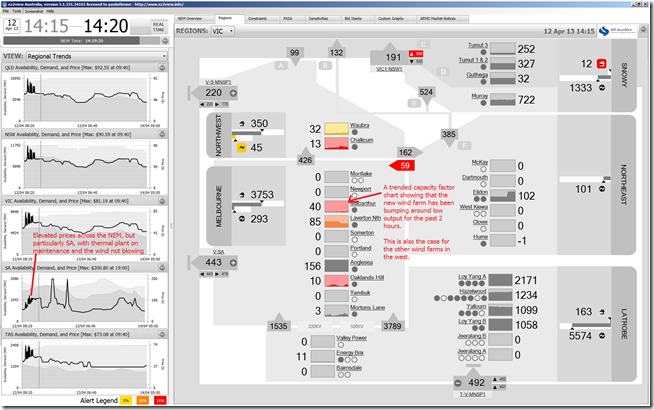This article from Daniel Palmer at the Climate Spectator today reminded us of the fact that the Macarthur Wind Farm was opened today, to claim the mantle as the largest wind farm in the Southern Hemisphere.
The plant boasts some impressive statistics for overall size, and size of turbines (3MW each) etc, and is located in one of the best locations in the NEM for wind harvesting.
We took a quick look at the Victorian regional display within ez2view but unfortunately noted that Mother Nature did not get the invitation to the event, or already had other engagements:
Also shown on the dashboard snapshot is the way in which prices have been slightly elevated across the NEM today, following on from higher prices in SA for the past couple days, on the back of lower available generation capacity from the generation fleet across the NEM (due to scheduled maintenance planned each year for the lower-demand shoulder months).
If certain advocates of wind power are to claim that wind farms have a hand in keeping spot prices low (when they generate, as discussed here), it seems only balanced to highlight what happens when it does not.
PS – yes, before anyone chooses to comment below, we do understand that wind farms are a type of generation built for energy production, not capacity supply, as we’ve noted before – but we could not help to laugh at the irony.
The thought of postponing the opening must have occurred to the organisers when the weather forecasts were produced in advance (there would have been thoughts that there would have been cheeky comments such as this being made).



‘Official’ is such a meaningless word, Macarthur has been dispatched for energy since late last year. Congratulations to the boys and girls at AGL, Vestas and Leighton on their hard work!
Thanks Peter,
With reference to NEM-Review it looks like it’s already produced about 371GWh over the period – so already contributing to reducing emissions.
Cheers
Paul
>”Already contributing to reducing emissions”
How much emissions has it abated? How much will it abate per year? How do you know?
Will it be more effective at abating emissions than wind power in Ireland (EirGrid)*? How do you know?
What will be the abatement cost ($/t CO2)?
* For those who don’t know, wind power in Ireland is about 53% effective at reducing emissions (17% wind energy proportion of total energy).
Joe Wheatley (2012) (in press) “Quantifying CO2 savings from wind power: Ireland” http://docs.wind-watch.org/Wheatley-Ireland-CO2.pdf
Hi Paul. I really appreciate your input into the electricity supply debate.
I have been reading the gushing reports about Macarthur wind farm and was wondering if the wind might come to the party. Probably a bit sad that it didn’t show up for the paperartzi.
A debate I am having on various blogs is the issue of dispatchability as the renewable advocates claim that baseload is a myth (read Mark Diesendorf) and even so, wind power can supply baseload (contradiction accepted).
So your comment about wind farms being a type of generation built for energy production, not capacity supply is what I’m trying to explain to these rather over zealous advocates who don’t seem to understand the importance of capacity if we are going to have a reliable network. It continues to be a tough sell for those that don’t want to really understand how electricity networks actual work.
Thanks Martin
The industry was already a complex beast pre-market, then the market came along and the complexity (and data load) increased. Add in a social drive to increase renewables and lower emissions and the complexity has ratcheted further.
Part of the noise in the debate reminds me of the story of blind people gathered around an elephant trying to describe what it is by the different components they each feel.
Paul
Hi Martin,
I agree that capacity reserves are vital to a reliable network, however peak capacity is currently not a barrier to increased renewable installation. It will be a barrier in several decades perhaps.
Currently the main barrier is cost of RE vs. incumbent fossil fuels. As the price drops more and more RE will be installed at least to the point where oversupply will become the next hurdle. This is where the price will be unprofitable for significant periods of time for coincident RE generators (e.g. with 20 GW of PV noon will be the cheapest part of the day).
RE will not be able to mount this hurdle without energy storage or more flexible consumers. If these requirements are met then back-up capacity becomes an issue. It’s pretty easy to solve too – build OCGTs.
May I remind you of the current situation in SA? 25+% Wind power and no new peaking capacity added. Maybe when they get to 35% and the remaining coal plants shut down there will be a need to build some more peakers.
On your point about baseload; any technology can supply baseload, it’s just that no one cares to. If all the baseloaders were gone we could still run a peaker at night.